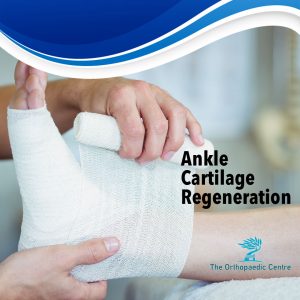
When one has an injury and suffers a cut or a bruise, the body cells will heal and regenerate. However, cartilage has a limited regenerative ability once it has been damaged. This can cause tissue damage with a residual defect to the area. This usually leads to swelling, constant pain, and limited mobility.
The ankle joint has been found to have the highest occurrence of cartilage injury (osteochondral lesions). They are always neglected when it has not been diagnosed previously and not commonly understood what can be done to deal with this problem.
For one with a serious ankle injury, one may require ankle cartilage regeneration. Dr David Su has been an early adopter in Singapore in using tissue scaffolds in cartilage regeneration in the ankle joint. Dr Su uses tissue scaffolds, and plenty of patients have recovered and resumed sports after a period of rehabilitation.
As an orthopaedic surgeon and foot and ankle sub-specialist, Dr David Su has the specific knowledge and experience to help patients suffering from problems in this area, leading them on the route to recovery.
Ankle fractures can occur as a result of twisting injuries to the ankle region during sports or sustained due to falls from heights. They can also occur with less trauma if the patient has a background of osteoporosis.
Patients would present with pain and swelling around the ankle and have difficulty weight-bearing.
Diagnosis is confirmed with the help of X-rays, and sometimes CT scan is required to further delineate injury in complex ankle fractures. Delayed diagnosis can result in a more complex surgery if surgery is required, longer healing time and arthritis in the long run.
Not all ankle fractures require surgery. If the fracture is stable, and the joint is intact, the fracture may be treated in a cast. Recovery from an ankle fracture depends on the severity of the fracture, however, most patients should expect at least three months of relying either on crutches or walking aid.
Foot drop refers to the difficulty of lifting the front part of the foot. It occurs when the muscles and tendons pulling the foot up are unable to function. If you have foot drop, you will have difficulty walking as your foot or toes are constantly dragging on the ground.
Tendon transfer may be used to treat foot drop when wearing a brace or physical therapy is not a viable option. It is a procedure in which a functioning tendon and its muscles is taken from another part of the foot to replace the one from the drop foot.
Complications from diabetes include nerve damage and poor blood circulation. These complications can lead to development of foot sores and ulcers that are difficult to treat. It is important to have proper diabetes management and foot care in preventing diabetes amputation of the foot. The Orthopaedic Centre provides foot care management and diabetes amputation prevention services.
In general, most orthopaedic specialist can handle a straight forward joint replacement surgery. A complex joint replacement include cases where there is severe deformities, very limited motion or the primary surgery has gone wrong (due to aseptic loosening, poor alignmet or infection).
As modern medicine improves the lifespan for males and females, patients with previous surgeries and implants who need a joint replacement surgery become very challenging as conventional techniques cannot be used.
Dr Chin Pak Lin had been the key person in handling complex and revision joint replacement surgeries formerly at SGH.
Bunions are a common problem which are often hereditary and exacerbated by footwear. The standard of care for painful bunions is now the scarf osteotomy. The scarf osteotomy ensures removal of the bunion, shifting the bones back to an optimal position and gives good outcomes. Patients are allowed to walk with protective foot wear in the immediate post-operative period. Many are usually very pleasantly surprised at the lack of discomfort.
Dr David Su has found that many patients have avoided addressing painful foot deformity as they have been misinformed that bunions recur after bunion surgery, resulting in needless suffering. With the scarf osteotomy, there is a very low recurrence rate. Patients are encouraged to return to sporting activity.
The foot and ankle is the commonest injured joint in sports. Whilst most patients who suffer ankle sprains recover spontaneously, some do not. More severe sprains result in chronic ankle instability and limitations in functions of daily living and sporting activity. There is potential risk of further damage to the joint once the biomechanics has been altered.
Ankle ligament reconstruction is performed to address ankle instability. With a short period of immobilisation and rehabilitation, patients are encouraged to return to sporting activity.
Minimally invasive surgery is performed to allow a faster recovery and shortened hospital stay. Ankle arthroscopy (putting a small camera into the ankle joint) is one such example. It is performed to address problems of chronic ankle pain resulting from impingement in the ankle joint.
Dr David Su, being an orthopaedic surgeon who is fellowship-trained in foot and ankle surgery, will be best able to address your concerns of foot and ankle problems
Flat feet (pes planus) sometimes causes pain due to stretching of ligaments & tendons or bony impingement due to the abnormal structure of the foot. If left unaddressed, some cases progress to arthritis of the midfoot and ankle joints.
Correction of this deformity may involve flat foot surgery where there are tendon transfers or bony procedures which are decided based on an individualised clinical assessment.